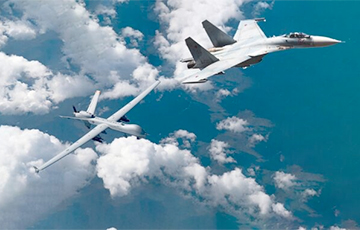Ukrainian Pilot: Russian Fighters Were Surely Ordered To Destroy American Drone
15- 15.03.2023, 14:02
- 20,186

There was a malicious intent.
Yesterday, on March 14, a Russian Su-27 fighter rammed an American reconnaissance UAV MQ-9 Reaper in international airspace over the Black Sea.
The Charter97.org website asked Colonel of the Ukrainian Armed Forces Reserve, pilot-instructor Roman Svitan to comment on the collision:
— It is clear that this was a planned action, malicious intent. The Russians received an order to intercept the drone, knowing full well that it had been flying there for several decades along the same route.
The MQ-9 Reaper is a drone that can carry more than a ton and a half of combat equipment, but it is a reconnaissance aircraft without missiles. This drone simply controls the air and sea space. Nearby NATO member countries are Romania and Bulgaria. Drones cover them, scan them. All on the standard route.
— Why did the Russians ram the drone and not hit it?
— They were definitely following orders to destroy the drone by some method of indirect weapon attack, which would look like an attack. They also performed several maneuvers, trying to knock it off course. They jumped out in front of it, turned on the afterburner, tried to just send it off into a tailspin. Nothing seemed to work out.
Then fuel was poured onto it. The Su-27 has more than nine tons of kerosene and has such a mechanism for dumping part of the fuel. It also didn't work. Although getting into a cloud of kerosene for any aircraft is not a very good moment. The engine catches fire when kerosene gets into it. There is an engine-air intake on top. In general, they tried to send it off in a spinning dive like that — it did not work out.
Then, most likely, they just mechanically approached from behind and hooked with the pylon of the aircraft, damaged the propeller and the drone could not fly further. It was probably blown up remotely so as not to get to the enemy. It should have a self-detonation mode — up to 50 kg of explosives inside for such cases.
I emphasize that this is clearly malicious intent, an order to destroy. An outrageous incident. This is combat damage.
Let's see how the United States and NATO countries react to this. It is their prerogative to make decisions.
— What damage could the Russian Su-27 have received during this operation?
— It is in the place with which it hooked the drone that it will definitely have damage. Again, this is most likely a pylon. This is such a connecting part with a half-wing of a rocket. It sticks out of the semi-wing down and some beams that can be simply damaged are changed and, in principle, the aircraft does not receive any damage as such. It turns out that the plane landed, the beam was removed, a new one was put in, and it flew on as if nothing had happened.
There are some aircraft where the air pressure receiver tubes stick out forward, they can be hooked. They also change quickly.
In general, the aircraft has something to knock out a non-maneuvering air target. It is likely that this was done.











